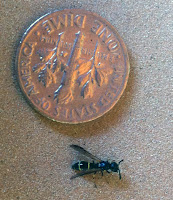Logs, cedar siding, and other wood structures are made of naturally occurring products, which make them attractive, appealing, and a 'green' renewable building choice. Unfortunately because it is naturally occurring, wood is also susceptible to the natural process of decay by insects and fungi. Forest products lab research has identified certain chemical compounds that help to fight the natural breakdown of wood. Interesting enough, Copper is a common denominator. Copper, in several different forms, preserves wood!
Copper 8 Quinolate
In order to control fungi and preserve wood, an effective antimicrobial pesticide used to protect the wood is Copper 8 Quinolate. Some log home wood stains like
WOODguard and
Outlast Q8 Log Oil are also registered with the EPA as preservatives because they contain copper 8 quinolate in order to protect the wood. As copper oxidizes and turns green, so the copper 8 quinolate can also make these log oils appear green. Fortunately, the green color will subside as the oil cures on the wood.
http://www.epa.gov/oppsrrd1/reregistration/copper-quinolate/
Copper Hydroxide
Certain compounds of Borate compounds like
Armor Guard and
PeneTreat are another preservative used to protect wood from insects and fungal decay, but certain species of fungus are not affected by Borates. For this reason, the Boron and Copper compounds are used together for more effective preservation. One example is a concentrated dowel-like preservative called
CobraRods. CobraRods are a wood preservative, fungicide and insecticide made entirely of a unique Boron and Copper Hydroxide complex. The addition of Copper Hydroxide provides extended protection from fungus species not affected by borates. They are inserted into wood as a solid rod and remain dormant until the wood comes to a moisture content of 20% or more as rot becomes a threat. When the wood is moist, the preservative slowly diffuses into the wood and kills the rot-causing fungi.
Chromated Copper Arsenate (CCA) & Alkaline Copper Quartenary (ACQ)
Pressure-treated wood has become a widely used product for decks, boardwalks, landscaping timbers, and other outdoor wooden structures. The green appearance in some formulas comes from the Copper in Chromated Copper Arsenate, which is pressure-treated into the wood for long-lasting protection. Alkaline Copper Quartenary (ACQ) is another formula used to pressure treat wood, and it comes in four variations for different species. Though CCA and ACQ have chemical differences, they share the aspects of preserving wood and containing Copper.
 http://www.epa.gov/oppad001/reregistration/cca/
http://www.epa.gov/oppad001/reregistration/cca/acq.htm
Copper Post Caps
http://www.epa.gov/oppad001/reregistration/cca/
http://www.epa.gov/oppad001/reregistration/cca/acq.htm
Copper Post Caps
One other way that Copper is used to protect wood is not by any chemical means, but rather through functional decoration. Railing and deck posts often have exposed end grain, which are susceptible to water absorption, which in turn creates moist conditions for rot to occur. It has become popular to protect the tops of those posts while adding a decorative flare with
copper post caps. In a similar fashion, Copper flashing has been using in lateral application to protect vulnerable areas of wood while adding a splash of shine and color for an aesthetic accent.



















